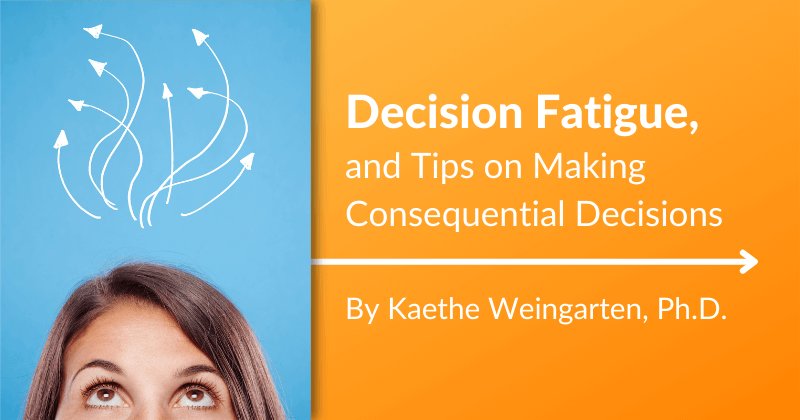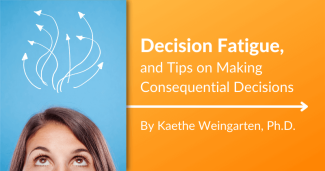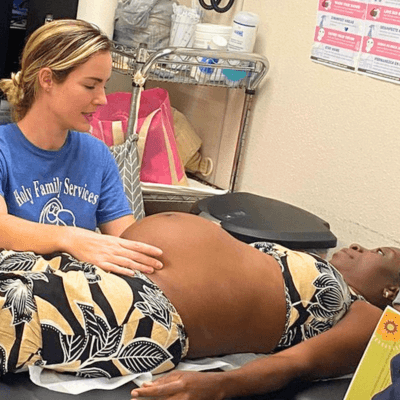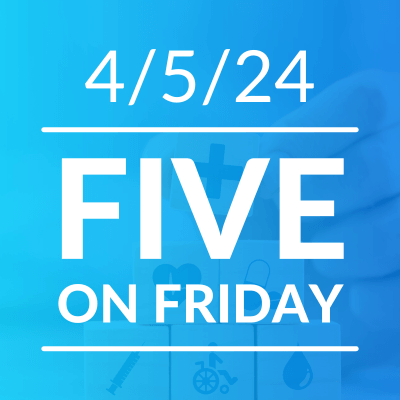Decision Fatigue, and Tips on Making Consequential Decisions

[Editor’s Note: Every month, MCN’s Director of Witness to Witness, Kaethe Weingarten, PhD, shares stories, resources, and helpful tips to support health care workers during these ongoing unprecedented times. Dr. Weingarten also offers a twice-monthly newsletter, filled with resources, recent articles, and her news and views. Sign up for the newsletter and grab bilingual resources on the Witness to Witness webpage.]
The average adult makes about 35,000 decisions a day. The average child only 3,000. (No wonder children complain that they don’t get enough choice!) I am unable to find the estimated number of decisions the average clinician makes each day, but if we stick with the 35,000 number, it certainly is a lot. Many of those decisions for clinicians will be made on behalf of their patients, so there is an added importance to having solid decision-making skills.
No one can be fully conscious of every decision they make. Many decisions are just doing what we always do: Turn off the alarm when it rings, put our feet into our slippers, head to the bathroom. You know your morning routine. For many of us, our decisions are on autopilot; we aren’t even aware we are making them. When people in one study estimated how many food decisions they made in a day, they estimated far off the mark, indicating they probably made around 15 food and beverage decisions a day. In fact, people make over 220 such decisions a day! Few of us are aware of those decisions or what is influencing us in making them.
It is exhausting to be aware of every decision, and our brains have accommodated to that by making some decisions automatically. The more choices we consciously make a day, the harder each one becomes, because each decision takes energy. We develop decision fatigue, a state of mental overload that reduces our capacity to make wise decisions. Many people became aware of decision fatigue during the pandemic because there were new choices and decisions to make daily that we couldn’t do on autopilot – should I go to the store now, or wait until next week, or have it delivered? The more choices per decision, the more exhausted we feel. If you have one blood draw location to send your patient, that is an easier choice than if there are ten potential sites to recommend.
Faced with so many decisions, consciously or not, we tend to opt for two tried-and-true energy-saving shortcuts: make an impulsive choice so as not to go through the more laborious process of considering multiple angles and the consequences of a potential decision, or do nothing. While doing nothing may cause future headaches, it saves mental energy and stress in the short term.
Decision fatigue is related to the concept of ego depletion, a term introduced by a social psychologist, Roy F. Baumeister. A core idea of Dr. Baumeister and his colleagues is that there is an analogy between decision fatigue and muscle fatigue: we drain ourselves of energy by working our decision-making muscle, our brain. The more patients a clinician has, the more ego depletion or decision fatigue that clinician will experience. With so many settings having personnel shortages these days, each health care worker is likely making even more decisions each day than five years ago. This will produce ego depletion or decision fatigue.
Ego depletion shows up in many ways, but a common thread is that we tend to feel everything more intensely, be it frustration, annoyance, irritation, anger, desire, or any other feeling. Research confirms what our wise mothers probably told us: don’t make an important decision on an empty stomach and a bad night’s rest.
Here are some other suggestions:
- Ask yourself if this is a good time to make a decision. If you are with a patient in the ED, this may not be useful question to ask yourself. If it is midnight and you are on a retail site on the computer, it may be a very good question to ask. You can follow up this question by asking another: Am I tired or hungry? If it is a decision that can wait until you have had a good night’s sleep and a nutritious breakfast, it’s likely it will be better to wait.
- Are you the right person to make the decision? If you are in a clinical situation and you are doubting your experience, this may be the right time to consult a colleague. If you are a parent and are uncertain how to engage your adolescent son, maybe his sport coach has some suggestions.
- Be clear about the values that underlie your decisions. If may be helpful to write out a list of your core values so that if you have a big decision to make, you can easily refer to your values list.
- Consider a method that Benjamin Franklin proposed in in 1772 in a letter to a friend who had asked his advice on a decision he had to make. Franklin wrote: “When these difficult cases occur, they are difficult chiefly because while we have them under Consideration all the Reasons pro and con are not present to the Mind at the same time.” He continues to suggest a method of taking a sheet of paper and drawing a line down the middle with the heading of one half of the sheet being pro and the other con. He suggests taking three or four days to fill out the two sides. Then he declares, “when each is considered separately and comparatively, and the whole lies before me, I think I can judge better, and am less likely to take a rash Step.” This pro/con method may seem obvious, but many people don’t use it. You can also assign a weight to each pro and con and then add up the scores of each column. I am not suggesting that arithmetic can solve major life decisions, but the numbers may be a useful indicator of factors we need to consider further.
Decisions are often hard. Delay may be wise or postponement may become a problem. Not deciding is still a decision. If I ask someone to make a decision and I hear nothing back, the silence is as loud a response as their providing me with their opinion.
Our lives are complicated and it is easy to understand why we defer, delay, or pass to others hard decisions. However, making decisions in a timely manner and at the right time is usually our best bet.
Here is one more idea. For many people, making decisions on their own is harder than doing it with a few other trusted people, whether this is in a personal or professional context. If you are going to put together a group to help you make a decision, it is important to remember a few facts about group decision-making. A truly diverse group will arrive at a more satisfactory decision than a homogenous group because the decision-making process will benefit from the information that some members of the group have that differs from everybody else. One way of thinking about this is to consider that members of a group with knowledge that no one else has are really key players in a group, in contrast to the members who share the same knowledge. Whoever has brought the group together wants to highlight the “peripheral” information to the group members who hold shared information.
Leaders have every reason to want to make the right decision the right way. Hilary Worthen, MD, a leadership consultant notes: “First, almost by definition, a right decision made the wrong way is a product of luck, and a certain number of times this will not work out. Second, the first thing people who are asked to carry out the results of a tough decision will ask is, “How did that get decided?”, and if they think an appropriate process was bypassed, their commitment to the work will be affected. Third, every decision is a moment of institutional learning about how to make decisions, and the more they are made the right way, the stronger the institutional capacity becomes.”
Worthen’s three points can apply to all of us. All of us are making thousands of decisions daily. Some are more consequential than others. For those that impact others beside ourselves, it is important to be as fit as we can be when we make those important decisions. We may want to bring in people with different perspectives and vantage points when a complex decision needs to be made that will have far reaching consequences. However, it’s important to convey at the outset to an assembled group that you are looking for diversity, not consensus, at first. When lots of different ideas are “on the table,” a group is much more likely eventually to arrive at a robust and useful decision.
References:
Tierney T. Do You Suffer From Decision Fatigue? New York Times. 17 August 2011. https://www.nytimes.com/2011/08/21/magazine/do-you-suffer-from-decision-fatigue.html
Hoomans J. 35,000 Decisions: The Great Choices of Strategic Leaders. Roberst Wesleyan College: The Leading Edge. 20 March 2015. https://go.roberts.edu/leadingedge/the-great-choices-of-strategic-leaders
Pignatiello GA, Martin RJ, Hickman RL Jr. Decision fatigue: A conceptual analysis. J Health Psychol. 2020;25(1):123-135. doi:10.1177/1359105318763510
Lang SS. ‘Mindless autopilot' drives people to dramatically underestimate how many daily food decisions they make, Cornell study finds. Cornell Chronicle. 22 December 2006. https://news.cornell.edu/stories/2006/12/mindless-autopilot-drives-people-underestimate-food-decisions
Stephen Johnson Farsighted: How we make the decisions that matter most. Riverhead books, 2018
Worthen, Hilary MD “Decision-making.” Available from the author at hilary.worthen@gmail.com.
- Log in to post comments






